Sedimentary Characteristics and Petroleum Geological Significance of the Middle–Upper Triassic Successions in the Wushi Area, Western Kuqa Depression, Tarim Basin
Abstract
1. Introduction
2. Geological Setting
3. Materials and Methods
3.1. Materials
3.2. Methods
4. Results
4.1. Sedimentary Facies Types and Their Characteristics
4.1.1. Fan-Delta
Fan-Delta Plain
Fan-Delta Front
4.1.2. Braided-River-Delta Depositional System
Braided-River-Delta Plain
Braided-River-Delta Front
4.1.3. Lacustrine
Littoral-Shallow Lacustrine
Semi-Deep Lacustrine
4.2. Spatial Distribution and Evolution of Sedimentary Facies
4.2.1. Single-Well Sedimentary Facies Evolution
4.2.2. Lateral Evolution of Sedimentary Facies
4.2.3. Spatial Stacking Patterns of Depositional Facies
4.2.4. Planar Distribution Characteristics of Sedimentary Facies
5. Discussion
5.1. Tectonic Controls on Depositional Systems
5.1.1. Paleogeomorphologic Framework Prior to Triassic Deposition: Controls on Facies Distribution
5.1.2. Foreland Tectonic Controls on Syn-Triassic Deposition
5.2. Petroleum-Geological Implications
5.3. Comparison with Previous Studies and Novelty of This Study
6. Conclusions
- (1)
- Integrated analysis demonstrates that the Triassic succession in the Wushi Sag comprises fan-delta, braided-river-delta, and lacustrine depositional systems exhibiting pronounced spatial differentiation. Northern foreland outcrops are characterized by fan-delta to lacustrine assemblages, whereas braided-river delta systems dominate the southern sector. From the Kelamayi to Huangshanjie formations, progressive retreat of northern fan deltas accompanied sustained northward progradation of braided-river deltas, culminating in maximum lacustrine expansion during Huangshanjie deposition, reflecting stage-specific configurations of sedimentary architecture.
- (2)
- Spatiotemporal distribution of these depositional systems is governed by multifactorial controls—tectonic activity, sediment supply, and paleoclimate—with tectonics exerting primary influence. Pre-Triassic paleotopography established preferential sediment dispersal conduits that dictated initial depositional patterns, while syndepositional foreland tectonism triggered provenance uplift and basinal subsidence. This dynamic regime drove persistent northward migration of depositional centers and expansion of lacustrine domains, ultimately defining the basin-fill framework.
- (3)
- Systematic evaluation of source rock potential, reservoir properties, source–reservoir configurations, and migration pathways reveals that hydrocarbon enrichment prospects concentrate within braided-river delta zones (south) and fan-delta belts (north). These intervals exhibit high-magnitude gas generation capacity, well-developed multimodal pore systems in reservoirs, and efficient fault-sandstone carrier networks. They facilitate two principal trap types: stratigraphic and structural-stratigraphic composite accumulations. The spatiotemporal coupling of these critical elements designates this trend as a strategic exploration target in foreland basin settings, with its hydrocarbon accumulation model holding broader implications for resource assessment in complex structural terrains.
Author Contributions
Funding
Institutional Review Board Statement
Informed Consent Statement
Data Availability Statement
Conflicts of Interest
References
- DeCelles, P.G.; Giles, K.A. Foreland Basin Systems. Basin Res. 1996, 8, 105–123. [Google Scholar] [CrossRef]
- Nabavi, S.T.; Fossen, H. Thrust and Nappe Tectonics in Orogenic Settings—A Historical Review. Earth-Sci. Rev. 2025, 266, 105139. [Google Scholar] [CrossRef]
- Bouzekraoui, M.; Saadi, M.; Essalhi, M.; Karaoui, B.; Hilali, M.; Jayadi, S.; Bahaj, T. Extensional Tectonics, Structural Architecture Modeling and Geodynamic Evolution in the Cretaceous Tinghir-Errachidia-Boudenib Basin (Pre-African Trough, Morocco). J. Afr. Earth Sci. 2023, 203, 104957. [Google Scholar] [CrossRef]
- Vijaya Rao, V.; Laxminarayana, K.; Mandal, B.; Karuppannan, P.; Kumar, P. Synthesis of Structure and Tectonic Evolution of Meso-Neoproterozoic Vindhyan Basin, India Using Geophysical and Geological Data: A Plate Tectonic Perspective. Precambrian Res. 2025, 422, 107787. [Google Scholar] [CrossRef]
- Hein, K.A.A.; Séjourné, S.; Ouédraogo, C.; Sidibé, G.; Dahl, R.; Coulibaly, G.K. The Volta Basin in Burkina Faso: Lithologic and Structural Geology Constraints along the Leading Edge of the Foreland Dahomeyide Fold-Thrust Belt. J. Afr. Earth Sci. 2025, 228, 105660. [Google Scholar] [CrossRef]
- Sieberer, A.-K.; Willingshofer, E.; Klotz, T.; Ortner, H.; Pomella, H. Control of Inherited Structures on Deformation and Surface Uplift: Crustal-Scale Analogue Modelling with Implications for the European Eastern Southern Alps. Tectonophysics 2025, 907, 230736. [Google Scholar] [CrossRef]
- Bonini, M.; Maestrelli, D.; Montanari, D.; Sani, F.; Balestrieri, M.L. Formation of Late-Stage Passive-Roof Duplexes in Fold-and-Thrust Belts: Thrusting Sequence and Thermochronologic Constraints from the Northern Apennines (Italy). Geosci. Front. 2025, 16, 102048. [Google Scholar] [CrossRef]
- Gharib, A.F.; Ismael, J.I.; Alatroshe, R.K.; Farhan, H.N.; Abdel-Fattah, M.I.; Pigott, J.D. Organic Matter Characteristics and Hydrocarbon Generation Potential of the Middle Jurassic-Lower Cretaceous Succession in the Mesopotamian Foredeep Basin, Iraq. Int. J. Earth Sci. (Geol. Rundsch.) 2024, 113, 2163–2187. [Google Scholar] [CrossRef]
- Chen, X.; Ji, Y.; Yang, K. Impacts of Sedimentary Characteristics and Diagenesis on Reservoir Quality of the 4th Member of the Upper Triassic Xujiahe Formation in the Western Sichuan Basin, Southwest China. Mar. Pet. Geol. 2024, 167, 106981. [Google Scholar] [CrossRef]
- Sun, X.; Alcalde, J.; Gomez-Rivas, E.; Owen, A.; Griera, A.; Martín-Martín, J.D.; Cruset, D.; Travé, A. Fluvial Sedimentation and Its Reservoir Potential at Foreland Basin Margins: A Case Study of the Puig-Reig Anticline (South-Eastern Pyrenees). Sediment. Geol. 2021, 424, 105993. [Google Scholar] [CrossRef]
- Li, J.; Zhang, X.; Tian, J.; Liang, Q.; Cao, T. Effects of Deposition and Diagenesis on Sandstone Reservoir Quality: A Case Study of Permian Sandstones Formed in a Braided River Sedimentary System, Northern Ordos Basin, Northern China. J. Asian Earth Sci. 2021, 213, 104745. [Google Scholar] [CrossRef]
- Li, Y.; Fan, A.; Yang, R.; Sun, Y.; Lenhardt, N. Sedimentary Facies Control on Sandstone Reservoir Properties: A Case Study from the Permian Shanxi Formation in the Southern Ordos Basin, Central China. Mar. Pet. Geol. 2021, 129, 105083. [Google Scholar] [CrossRef]
- Cloetingh, S.; Burov, E. Lithospheric Folding and Sedimentary Basin Evolution: A Review and Analysis of Formation Mechanisms: Lithospheric Folding and Sedimentary Basin Evolution. Basin Res. 2011, 23, 257–290. [Google Scholar] [CrossRef]
- Bjørlykke, K. Relationships between Depositional Environments, Burial History and Rock Properties. Some Principal Aspects of Diagenetic Process in Sedimentary Basins. Sediment. Geol. 2014, 301, 1–14. [Google Scholar] [CrossRef]
- Matenco, L.C.; Haq, B.U. Multi-Scale Depositional Successions in Tectonic Settings. Earth-Sci. Rev. 2020, 200, 102991. [Google Scholar] [CrossRef]
- Kakemem, U.; Ghasemi, M.; Adabi, M.H.; Husinec, A.; Mahmoudi, A.; Anderskouv, K. Sedimentology and Sequence Stratigraphy of Automated Hydraulic Flow Units—The Permian Upper Dalan Formation, Persian Gulf. Mar. Pet. Geol. 2023, 147, 105965. [Google Scholar] [CrossRef]
- Abdlmutalib, A.J.; Ayranci, K.; Yassin, M.A.; Hussaini, S.R.; Abdullatif, O.A.; Humphrey, J.D. Impact of Sedimentary Fabrics on Small-Scale Permeability Variations within Fine-Grained Sediments: Early Silurian Qusaiba Member, Northern Saudi Arabia. Mar. Pet. Geol. 2022, 139, 105607. [Google Scholar] [CrossRef]
- Yıldız, G. Late Paleozoic-Early Mesozoic Paleotectonics of the Northern Arabian Plate (SE Turkey) and Its Role in the Paleozoic Petroleum System. Mar. Pet. Geol. 2022, 137, 105529. [Google Scholar] [CrossRef]
- Xiao, D.; Cao, J.; Tan, X.; Xiong, Y.; Zhang, D.; Dong, G.; Lu, Z. Marine Carbonate Reservoirs Formed in Evaporite Sequences in Sedimentary Basins: A Review and New Model of Epeiric Basin-Scale Moldic Reservoirs. Earth-Sci. Rev. 2021, 223, 103860. [Google Scholar] [CrossRef]
- Kakemem, U.; Jafarian, A.; Husinec, A.; Adabi, M.H.; Mahmoudi, A. Facies, Sequence Framework, and Reservoir Quality along a Triassic Carbonate Ramp: Kangan Formation, South Pars Field, Persian Gulf Superbasin. J. Pet. Sci. Eng. 2021, 198, 108166. [Google Scholar] [CrossRef]
- Hawie, N.; Al-Wazzan, H.; Al-Ali, S.; Al-Sahlan, G. De-Risking Hydrocarbon Exploration in Lower Jurassic Carbonate Systems of Kuwait through Forward Stratigraphic Models. Mar. Pet. Geol. 2021, 123, 104700. [Google Scholar] [CrossRef]
- Sissakian, V.K.; Ghafur, A.A.; Sherwani, G.H.; Abdulhaq, H.A.; Omer, H.O. New Structural Findings in Bijeel-Aqra Vicinity, Kurdistan Region of Iraq: Insight into Oil Exploration and Hydrocarbon Maturation. J. Afr. Earth Sci. 2025, 230, 105729. [Google Scholar] [CrossRef]
- Akbarzadeh, S.; Davoodi, S.; Hosseinzadeh, S.; Tavakoli, V. Integrated Sedimentological and Petrophysical Analyses for Improved Reservoir Characterization in the Sequence Stratigraphy Framework, Fahliyan Formation, Southwest Iran. J. Afr. Earth Sci. 2025, 229, 105699. [Google Scholar] [CrossRef]
- GholamiZadeh, P.; Wan, B.; Meinhold, G.; Esmaeili, R.; Ebrahimi, M. Provenance Evolution from Subduction to Arc-Continent Collision: An Example from Zagros–Makran Transition Zone. Geosci. Front. 2025, 16, 102079. [Google Scholar] [CrossRef]
- Elyad, S.; Yassaghi, A.; Najafi, M. Structural Evolution of Anticlines over the Hendijan Paleo-High in the Northwestern Persian Gulf: Insights into the Influence of Inherited Basement Faults. Mar. Pet. Geol. 2025, 180, 107479. [Google Scholar] [CrossRef]
- Ding, F.; Wang, G.; Xue, M.; Sun, Y.; Liu, Y.; Sun, J.; Li, F. Cases of Possible Structural-Stratigraphic Accumulations in the Oriente Basin, Analysis on Their Accumulation Mechanisms and Implication for Future Exploration. Energy Geosci. 2025, 100435. [Google Scholar] [CrossRef]
- Zhu, S.; Sun, P.; Zhang, K.; Zhang, C.; Zhang, Q.; Li, B.; Wang, J.; Jiang, S.; Bao, L.; Jing, G.; et al. Paleogeographic Reconstruction and Sedimentary Evolution of Tidal-Dominated Estuarine Depositional Systems: Insights from the Campanian M1 Sandstone Formation, Oriente Basin, Ecuador. Mar. Pet. Geol. 2024, 170, 107125. [Google Scholar] [CrossRef]
- Ji, Y.; Ding, X.-Z.; Li, X.-C.; Yu, K.-N. Triassic Paleogeography and Sedimentary Facies of the Kuqa Depression Tarim Basin. J. Geomech. 2003, 9, 268–274. [Google Scholar]
- Huang, K.; Zhan, J.; Zou, Y.; Wang, Z.; Zhou, C.; Xiao, J. Sedimentary Environments and Palaeoclimate of the Triassic and Jurassic in Kuqa River Area Xinjiang. J. Palaeogeogr. 2003, 5, 197–208. [Google Scholar]
- Zhao, W.; Zhang, S.; Wang, F.; Cramer, B.; Chen, J.; Sun, Y.; Zhang, B.; Zhao, M. Gas Systems in the Kuche Depression of the Tarim Basin: Source Rock Distributions, Generation Kinetics and Gas Accumulation History. Org. Geochem. 2005, 36, 1583–1601. [Google Scholar] [CrossRef]
- Wang, Q.; Yang, H.; Yang, W. New Progress and Future Exploration Targets in Petroleum Geological Research of Ultra-Deep Clastic Rocks in Kuqa Depression, Tarim Basin, NW China. Pet. Explor. Dev. 2025, 52, 79–94. [Google Scholar] [CrossRef]
- Dong, C.; Zhang, L.; Yang, W.; Xu, Z.; Li, J.; Miao, W. Accumulation Process and Potential of Jurassic Tight Sandstone Oil and Gas in Eastern Yangxia Sag of Kuqa Depression. China Geol. 2025, 8, 389–407. [Google Scholar] [CrossRef]
- Xu, X.; Zeng, L.; Dong, S.; Li, H.; Liu, J.; Ji, C. The Characteristics and Controlling Factors of High-Quality Reservoirs of Ultra-Deep Tight Sandstone: A Case Study of the Dabei Gas Field, Tarim Basin, China. Pet. Sci. 2025; in press. [Google Scholar] [CrossRef]
- Zhao, Z.; Yang, W.; Zhao, Z.; Xu, W.; Gong, D.; Jin, H.; Song, W.; Liu, G.; Zhang, C.; Huang, S. Research Progresses in Geological Theory and Key Exploration Areas of Coal-Formed Gas in China. Pet. Explor. Dev. 2024, 51, 1435–1450. [Google Scholar] [CrossRef]
- Ji, L. On Sedimentary Facies and Reservoir Features of Mesozoic Erathem in Wushi Sag in Xinjiang. Master’s Thesis, Chang’an University, Xi’an, China, 2007. [Google Scholar]
- Liu, Y.; Hu, X.; Wang, D.; Zhao, Y.; Zhang, Q.; Wen, L. Characteristics of Triassic lithofacies palaeogeography in Tarim Basin. Fault-Block Oil Gas Field 2012, 19, 696–700. [Google Scholar]
- Zhang, R.; Wang, Z.; Yu, C.; Yang, Z.; Zhi, F. Sedimentary and Reservoir Characteristics and Hydrocarbon Exploration Significance of Triassic Taliqike Formation in Kuqa Depression. Earth Sci. 2024, 49, 40–54. [Google Scholar]
- Li, J.; Wang, R.; Qin, S.; Shi, W.; Geng, F.; Luo, F.; Li, G.; Zhang, X. Evolution of Mesozoic Paleo-Uplifts and Differential Control on Sedimentation on the Southern Margin of Kuqa Depression, Tarim Basin. Mar. Pet. Geol. 2024, 161, 106707. [Google Scholar] [CrossRef]
- Wang, Z.; Cheng, J.; Zhang, R. Sedimentary characteristics and geological significance of Upper Triassic Huangshanjie Formation in Kuqa Depression. Geol. Rev. 2025, 71, 82–98. [Google Scholar]
- Cai, J.; Lü, X. Substratum Transverse Faults in Kuqa Foreland Basin, Northwest China and Their Significance in Petroleum Geology. J. Asian Earth Sci. 2015, 107, 72–82. [Google Scholar] [CrossRef]
- Liu, J.; Yang, X.; Liu, K.; Xu, Z.; Jia, K.; Zhou, L.; Wei, H.; Zhang, L.; Wu, S.; Wei, X. Differential Hydrocarbon Generation and Evolution of Typical Terrestrial Gas-Prone Source Rocks: An Example from the Kuqa Foreland Basin, NW China. Mar. Pet. Geol. 2023, 152, 106225. [Google Scholar] [CrossRef]
- Yu, G.; Liu, K.; Xi, K.; Yang, X.; Yuan, J.; Xu, Z.; Zhou, L.; Hou, S. Variations and Causes of in-Situ Stress Orientations in the Dibei-Tuziluoke Gas Field in the Kuqa Foreland Basin, Western China. Mar. Pet. Geol. 2023, 158, 106528. [Google Scholar] [CrossRef]
- Wang, M.; Zhang, J.; Liu, K. Continuous Denudation and Pediplanation of the Chinese Western Tianshan Orogen during Triassic to Middle Jurassic: Integrated Evidence from Detrital Zircon Age and Heavy Mineral Chemical Data. J. Asian Earth Sci. 2015, 113, 310–324. [Google Scholar] [CrossRef]
- Zhang, Z.; Tang, P.; Sun, J.; Ren, Z. Chronology, Structures and Salt Tectonics in the Northern Kuqa Depression, NW China: Implications for the Cenozoic Uplift of Tian Shan and Foreland Deformation. Glob. Planet. Change 2024, 243, 104618. [Google Scholar] [CrossRef]
- Wu, G.; Lin, C.; Yang, H.; Liu, J.; Liu, Y.; Li, H.; Yang, X.; Jiang, J.; He, Q.; Gao, D. Major Unconformities in the Mesozoic Sedimentary Sequences in the Kuqa–Tabei Region, Tarim Basin, NW China. J. Asian Earth Sci. 2019, 183, 103957. [Google Scholar] [CrossRef]
- Abdel-Fattah, M.I.; Pigott, J.D.; El-Sadek, M.S. Integrated Seismic Attributes and Stochastic Inversion for Reservoir Characterization: Insights from Wadi Field (NE Abu-Gharadig Basin, Egypt). J. Afr. Earth Sci. 2020, 161, 103661. [Google Scholar] [CrossRef]
- Hu, X.; Zhu, X.; Jin, X.; Huang, C.; Cheng, C.; Xiu, J.; Ren, X.; Zheng, D. Seismic Sedimentology Analysis of Meter-Scale Thin Sand Bodies in the Jurassic Qigu Formation, Yongjin Area, Junggar Basin. Mar. Pet. Geol. 2024, 169, 107079. [Google Scholar] [CrossRef]
- Dong, Y.; Zhang, M.; Zhu, X.; Jiang, Q.; Guo, L.; Wei, M. Seismic Geomorphology and Depositional System of Delta and Terminal Fan: A Case Study of the Neogene Shawan Formation in the Chepaizi Uplift, Junggar Basin, China. Mar. Pet. Geol. 2017, 83, 362–381. [Google Scholar] [CrossRef]
- Jiang, Z. Sedimentary Dynamics of Windfield-Source-Basin System: New Concept for Interpretation and Prediction. In Sedimentary Dynamics of Windfield-Source-Basin System: New Concept for Interpretation and Prediction; Springer Geology; Springer International Publishing Ag: Cham, Switzerland, 2018; pp. 1–328. ISBN 978-981-10-7407-3. [Google Scholar]
- Kövecsi, S.-A.; Less, G.; Pleș, G.; Bindiu-Haitonic, R.; Briguglio, A.; Papazzoni, C.A.; Silye, L. Nummulites Assemblages, Biofabrics and Sedimentary Structures: The Anatomy and Depositional Model of an Extended Eocene (Bartonian) Nummulitic Accumulation from the Transylvanian Basin (NW Romania). Palaeogeogr. Palaeoclimatol. Palaeoecol. 2022, 586, 110751. [Google Scholar] [CrossRef]
- McNabb, J.C.; Dorsey, R.J.; Housen, B.A.; Dimitroff, C.W.; Messé, G.T. Stratigraphic Record of Pliocene-Pleistocene Basin Evolution and Deformation within the Southern San Andreas Fault Zone, Mecca Hills, California. Tectonophysics 2017, 719–720, 66–85. [Google Scholar] [CrossRef]
- Olariu, M.I.; Aiken, C.L.V.; Bhattacharya, J.P.; Xu, X. Interpretation of Channelized Architecture Using Three-Dimensional Photo Real Models, Pennsylvanian Deep-Water Deposits at Big Rock Quarry, Arkansas. Mar. Pet. Geol. 2011, 28, 1157–1170. [Google Scholar] [CrossRef]
- Lu, X.; Sun, D.; Xie, X.; Chen, X.; Zhang, S.; Zhang, S.; Sun, G.; Shi, J. Microfacies Characteristics and Reservoir Potential of Triassic Baikouquan Formation, Northern Mahu Sag, Junggar Basin, NW China. J. Nat. Gas Geosci. 2019, 4, 47–62. [Google Scholar] [CrossRef]
- Mcpherson, J.; Shanmugam, G.; Moiola, R. Fan-Deltas and Braid Deltas-Varieties of Coarse-Grained Deltas. Geol. Soc. Am. Bull. 1987, 99, 331–340. [Google Scholar] [CrossRef]
- Changsong, L.; Eriksson, K.; Sitian, L.; Yongxian, W.; Jianye, R.; Yanmei, Z. Sequence Architecture, Depositional Systems, and Controls on Development of Lacustrine Basin Fills in Part of the Erlian Basin, Northeast China. AAPG Bull. 2001, 85, 2017–2043. [Google Scholar] [CrossRef]
- Xue, L.; Galloway, W. Fan-Delta, Braid Delta and the Classification of Delta Systems. Acta Geol. Sin. (Engl. Ed.) 1991, 4, 387–400. [Google Scholar]
- Dong, Y.; Zhu, X.; Xian, B.; Hu, T.; Geng, X.; Liao, J.; Luo, Q. Seismic Geomorphology Study of the Paleogene Hetaoyuan Formation, Central-South Biyang Sag, Nanxiang Basin, China. Mar. Pet. Geol. 2015, 64, 104–124. [Google Scholar] [CrossRef]
- Tan, M.; Zhu, X.; Liu, W.; Tan, L.; Shi, R.; Liu, C. Sediment Routing Systems in the Second Member of the Eocene Shahejie Formation in the Liaoxi Sag, Offshore Bohai Bay Basin: A Synthesis from Tectono-Sedimentary and Detrital Zircon Geochronological Constraints. Mar. Pet. Geol. 2018, 94, 95–113. [Google Scholar] [CrossRef]
- Li, J.; Liu, S.; Zhang, J.; Fan, Z.; Sun, Z.; Zhang, M.; Yuan, Y.; Zhang, P. Architecture and Facies Model in a Non-Marine to Shallow-Marine Setting with Continuous Base-Level Rise: An Example from the Cretaceous Denglouku Formation in the Changling Depression, Songliao Basin, China. Mar. Pet. Geol. 2015, 68, 381–393. [Google Scholar] [CrossRef]
- Ji, H.; Zhong, J.; He, Z.; Chen, H.; Li, Z.; Qin, M.; Zhu, B.; Wu, Y.; Dong, Q. Jurassic Sedimentary Evolution Model and Its Implication for the Sandstone-Type Uranium Mineralization in the Kamusite Area in Eastern Junggar Basin, NW China. Ore Geol. Rev. 2024, 168, 106042. [Google Scholar] [CrossRef]
- Wang, J.; Zhou, Y.; Pang, J.; Tian, Y.; Ma, B.; Zhang, J.; Zhao, X.; Jiang, X. Late Miocene Palynological Records of Vegetation and Climate Changes in the Otindag Dune Field. Palaeogeogr. Palaeoclimatol. Palaeoecol. 2024, 643, 112198. [Google Scholar] [CrossRef]
- Li, C.; Li, B.; Li, Y.; Chen, B.; Xu, Q.; Zhang, W.; Liu, W.; Ding, G. Variation of Summer Monsoon Intensity in the North China Plain and Its Response to Abrupt Climatic Events during the Early-Middle Holocene. Quat. Int. 2020, 550, 66–73. [Google Scholar] [CrossRef]
- Juyal, N.; Pant, R.K.; Basavaiah, N.; Bhushan, R.; Jain, M.; Saini, N.K.; Yadava, M.G.; Singhvi, A.K. Reconstruction of Last Glacial to Early Holocene Monsoon Variability from Relict Lake Sediments of the Higher Central Himalaya, Uttrakhand, India. J. Asian Earth Sci. 2009, 34, 437–449. [Google Scholar] [CrossRef]
- Oliveira, E.J.; Souza, P.A.; Góes, A.M.; Félix, C.M.; Boardman, D.R.; Saturnino de Andrade, L.; Premaor, E.; Fambrini, G.L.; Rodrigues Nogueira, A.C.; Scomazzon, A.K. Deciphering Permian Wetland Deposits of the Parnaíba Basin through an Integrated Study of Lithofacies and Palynofacies in Western Gondwana. J. S. Am. Earth Sci. 2024, 148, 105177. [Google Scholar] [CrossRef]
- Liu, Z.; Wang, C. Facies Analysis and Depositional Systems of Cenozoic Sediments in the Hoh Xil Basin, Northern Tibet. Sediment. Geol. 2001, 140, 251–270. [Google Scholar] [CrossRef]
- Xu, Q.; Liu, B.; Song, X.; Wang, Q.; Chen, X.; Li, Y.; Zhang, Y. Hydrocarbon Generation and Organic Matter Enrichment of Limestone in a Lacustrine Mixed Sedimentary Environment: A Case Study of the Jurassic Da’anzhai Member in the Central Sichuan Basin, SW China. Pet. Sci. 2023, 20, 670–688. [Google Scholar] [CrossRef]
- Li, Z.; Zhang, L.; Were, P.; Wang, D. Sedimentary Characteristics of 1st Member of Yaojia Formation in Zhaoyuan-Taipingchuan Region of Songliao Basin. J. Pet. Sci. Eng. 2017, 148, 52–63. [Google Scholar] [CrossRef]
- Li, L.; Liu, Z.; Sun, P.; Li, Y.; George, S.C. Sedimentary Basin Evolution, Gravity Flows, Volcanism, and Their Impacts on the Formation of the Lower Cretaceous Oil Shales in the Chaoyang Basin, Northeastern China. Mar. Pet. Geol. 2020, 119, 104472. [Google Scholar] [CrossRef]
- Pang, X.-Q.; Li, Y.-X.; Jiang, Z.-X. Key Geological Controls on Migration and Accumulation for Hydrocarbons Derived from Mature Source Rocks in Qaidam Basin. J. Pet. Sci. Eng. 2004, 41, 79–95. [Google Scholar] [CrossRef]
- Wu, T.; Wang, Y.; Zhang, L.; Wu, J.; Sun, X.; Zheng, G. Forebulge Migration and Evolution of the Triassic in Tarim Basin. J. Palaeogeogr. (Chin. Ed.) 2013, 15, 219–230. [Google Scholar]
- Zeng, L.B.; Tan, C.X.; Zhang, M.L. Meso-cenozoic tectonic stress field and its hydrocarbon migration and accumulation effects in the kuqa depression of the Tarim Basin. Sci. China Ser. D Earth Sci. 2004, 34, 98–106. [Google Scholar]
- Li, Z.; Zhang, L.; Yuan, W.; Chen, X.; Zhang, L.; Li, M. Logging Identification for Diagenetic Facies of Tight Sandstone Reservoirs: A Case Study in the Lower Jurassic Ahe Formation, Kuqa Depression of Tarim Basin. Mar. Pet. Geol. 2022, 139, 105601. [Google Scholar] [CrossRef]
- Li, D.; Wang, G.-W.; Bie, K.; Lai, J.; Lei, D.-W.; Wang, S.; Qiu, H.-H.; Guo, H.-B.; Zhao, F.; Zhao, X.; et al. Formation Mechanism and Reservoir Quality Evaluation in Tight Sandstones under a Compressional Tectonic Setting: The Jurassic Ahe Formation in Kuqa Depression, Tarim Basin, China. Pet. Sci. 2025, 22, 998–1020. [Google Scholar] [CrossRef]
- Zhao, G.; Li, X.; Liu, M.; Li, J.; Liu, Y.; Zhang, X.; Wei, Q.; Xiao, Z. Accumulation Characteristics and Controlling Factors of the Tugeerming Gas Reservoir in the Eastern Kuqa Depression of the Tarim Basin, Northwest China. J. Pet. Sci. Eng. 2022, 217, 110881. [Google Scholar] [CrossRef]
- Jia, C.; Li, Q. Petroleum Geology of Kela-2, the Most Productive Gas Field in China. Mar. Pet. Geol. 2008, 25, 335–343. [Google Scholar] [CrossRef]
- Zheng, M.; Peng, G.; Lei, G.; Guo, H.; Huang, S.; Wu, C.; Li, Y. Structural Pattern and Its Control on Hydrocarbon Accumulations in Wushi Sag, Kuche Depression, Tarim Basin. Pet. Explor. Dev. 2008, 35, 444–451. [Google Scholar] [CrossRef]
- Zhao, L.; Ma, Y.; Yang, X.; Lei, G.; Wu, C. Characteristics of Hydrocarbon Pooling in Wushi Sag of Kuqa Foreland Basin. Nat. Gas Ind. 2008, 28, 21–24. [Google Scholar]
- Zheng, C.; Ning, S.; Han, Q.; Yan, L.; Bi, J. Prediction on Sequence Stratigraphy and Sedimentary Facies of Ehuobulake Formation in Kuqa Sag. Spec. Oil Gas Reserv. 2015, 22, 75–79. [Google Scholar]
- Yu, H.; Qi, J.; Yang, X.; Sun, T.; Liu, Q.; Cao, S. Analysis of Mesozoic Prototype Basin in Kuqa Depression, Tarim Basin. Xinjiang Pet. Geol. 2016, 37, 644–653, 666. [Google Scholar]
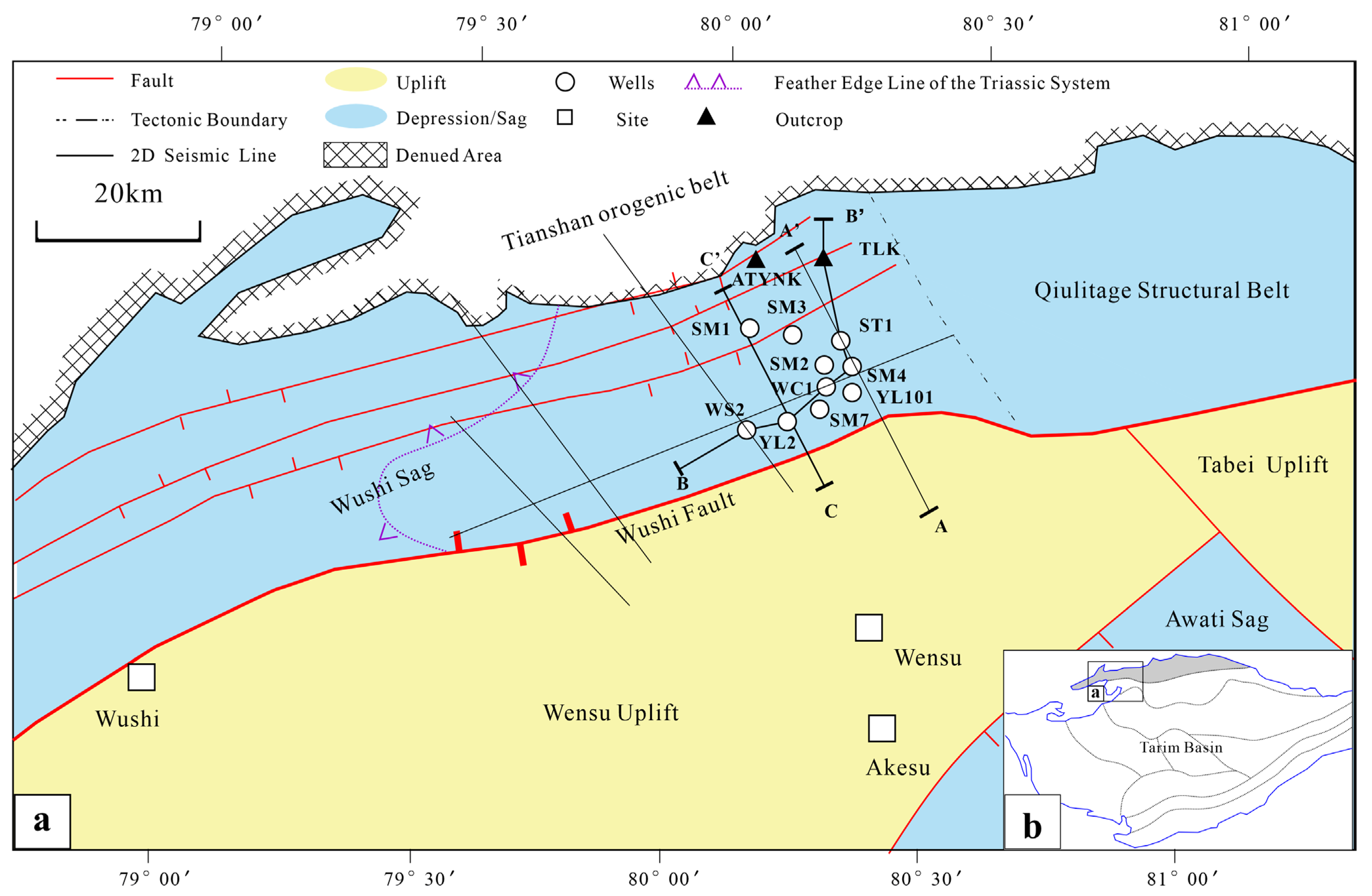
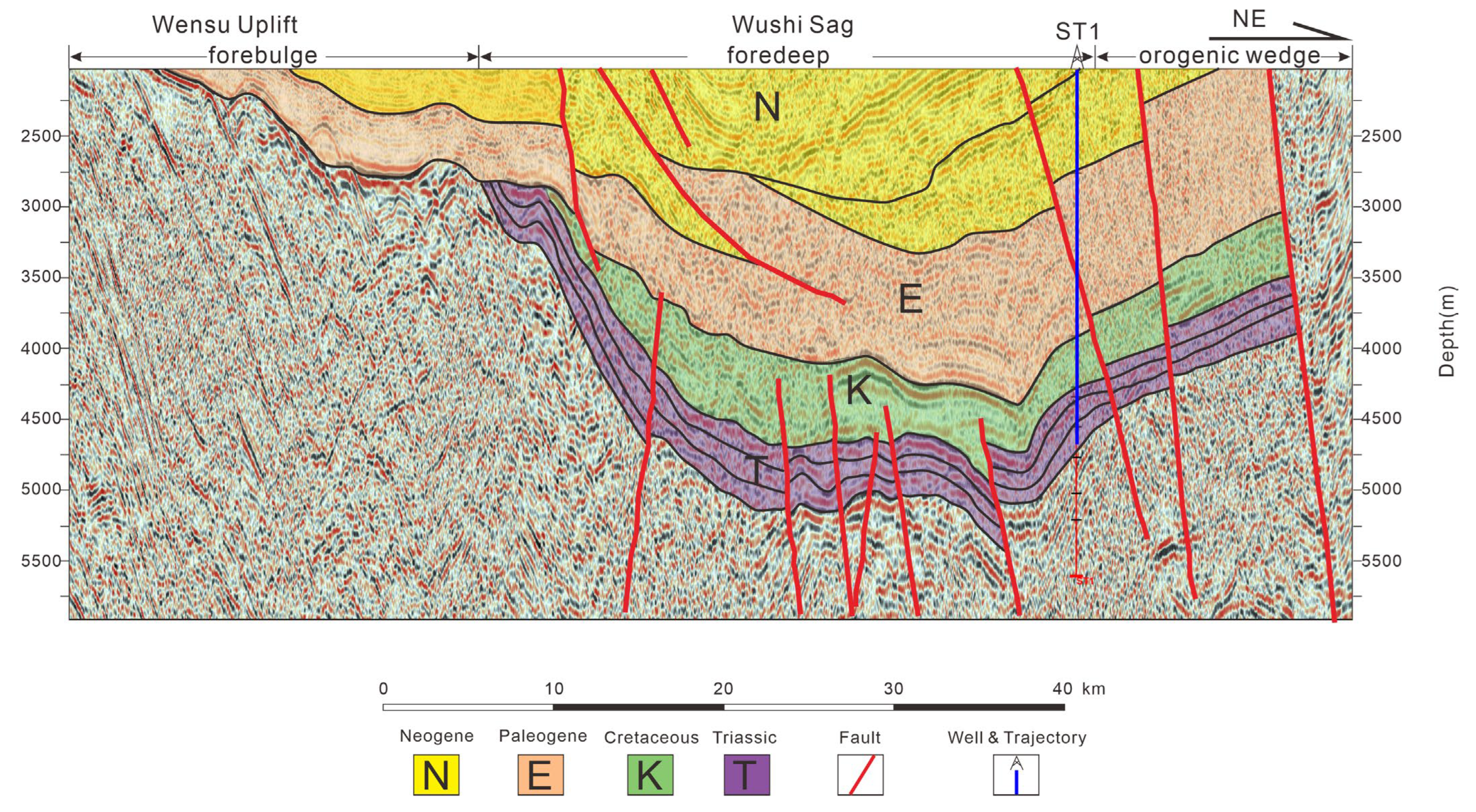
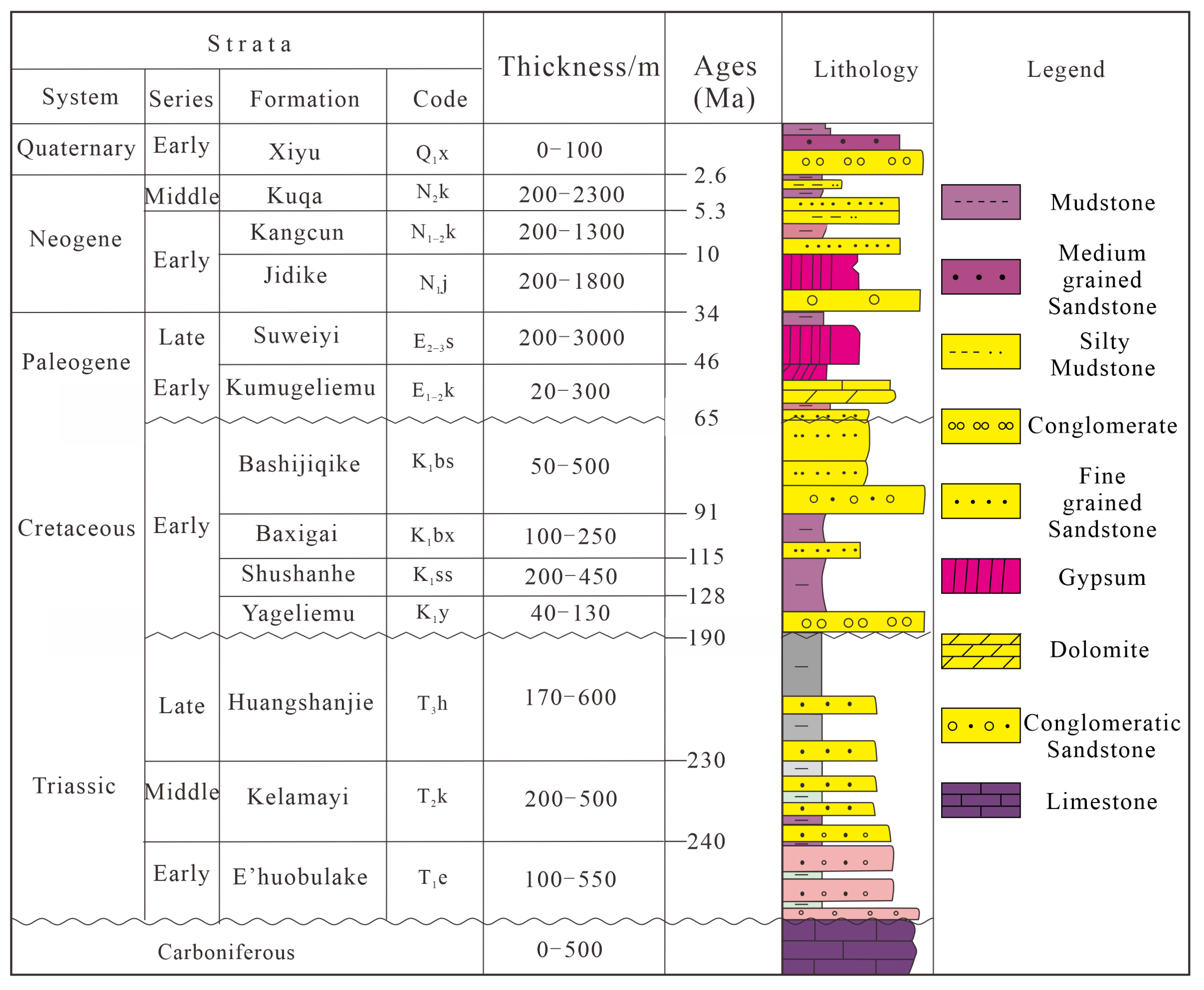
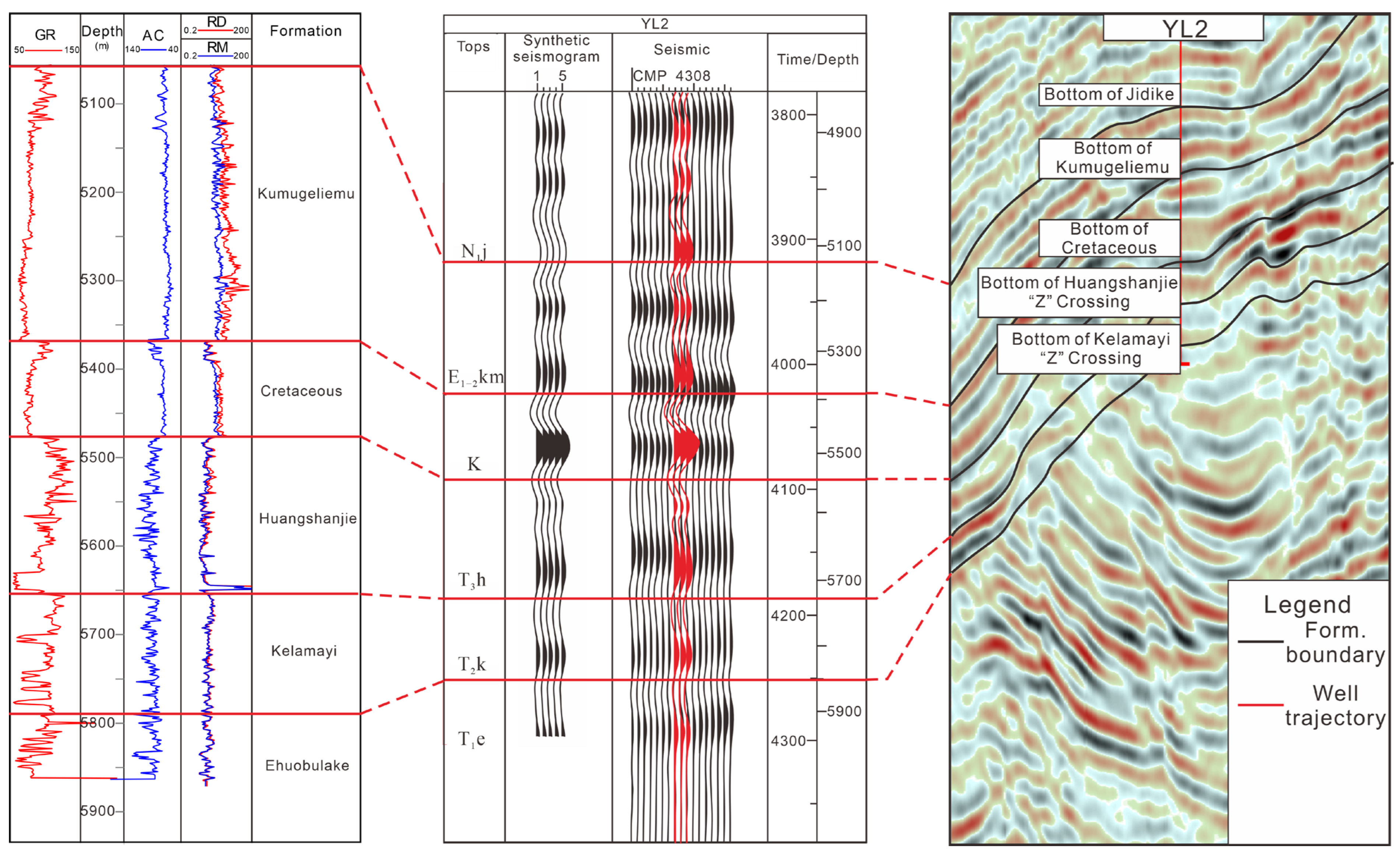
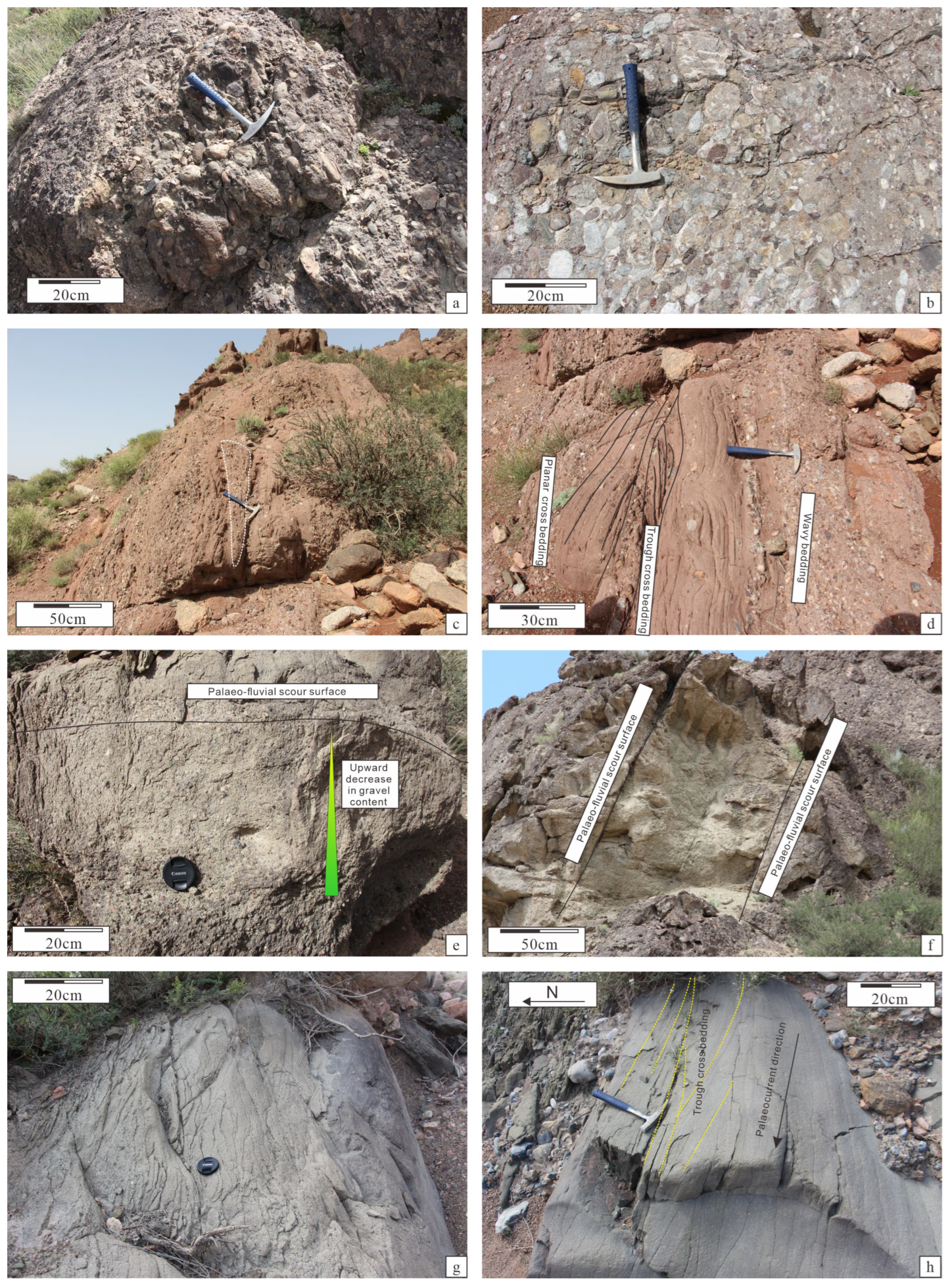
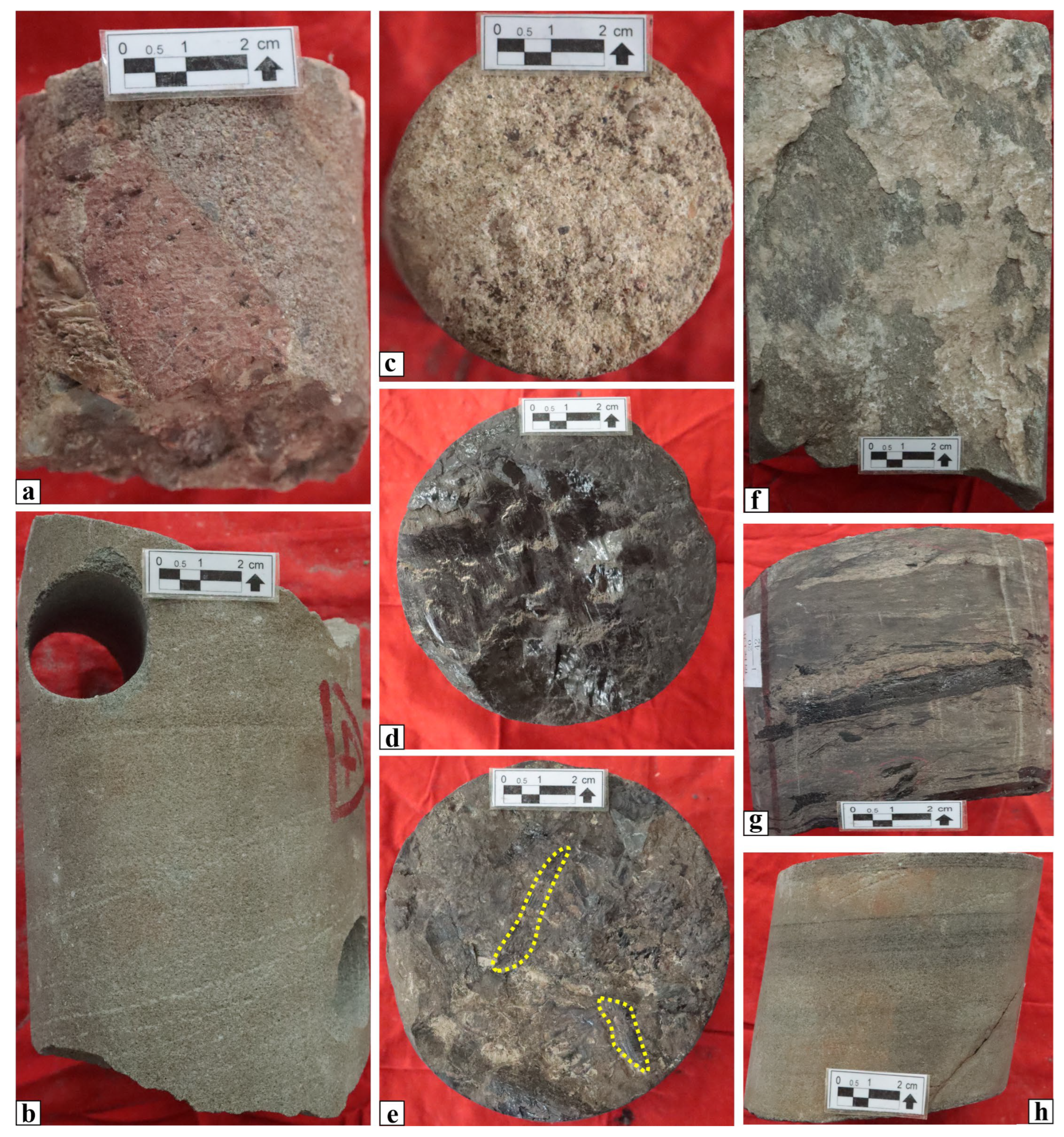
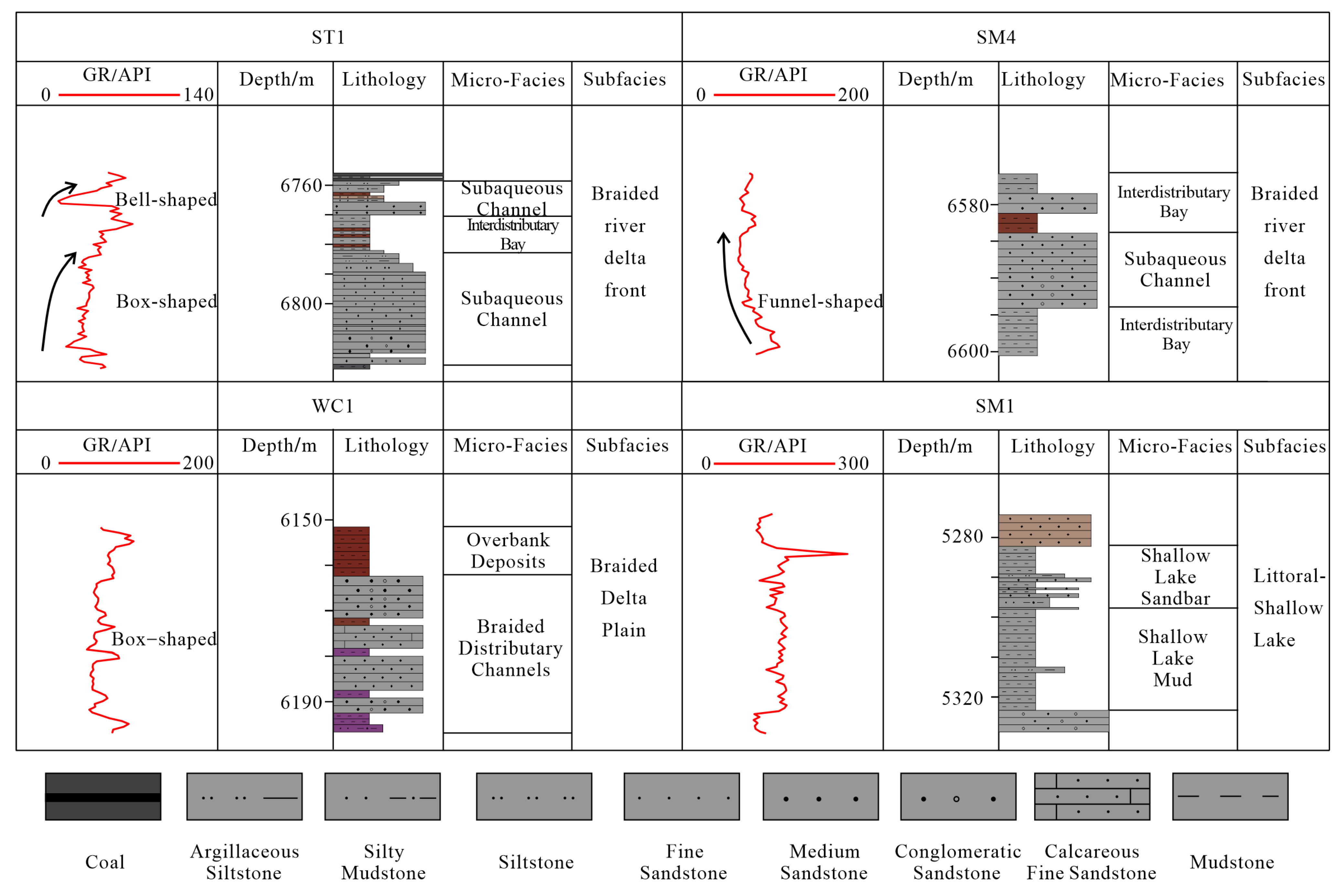
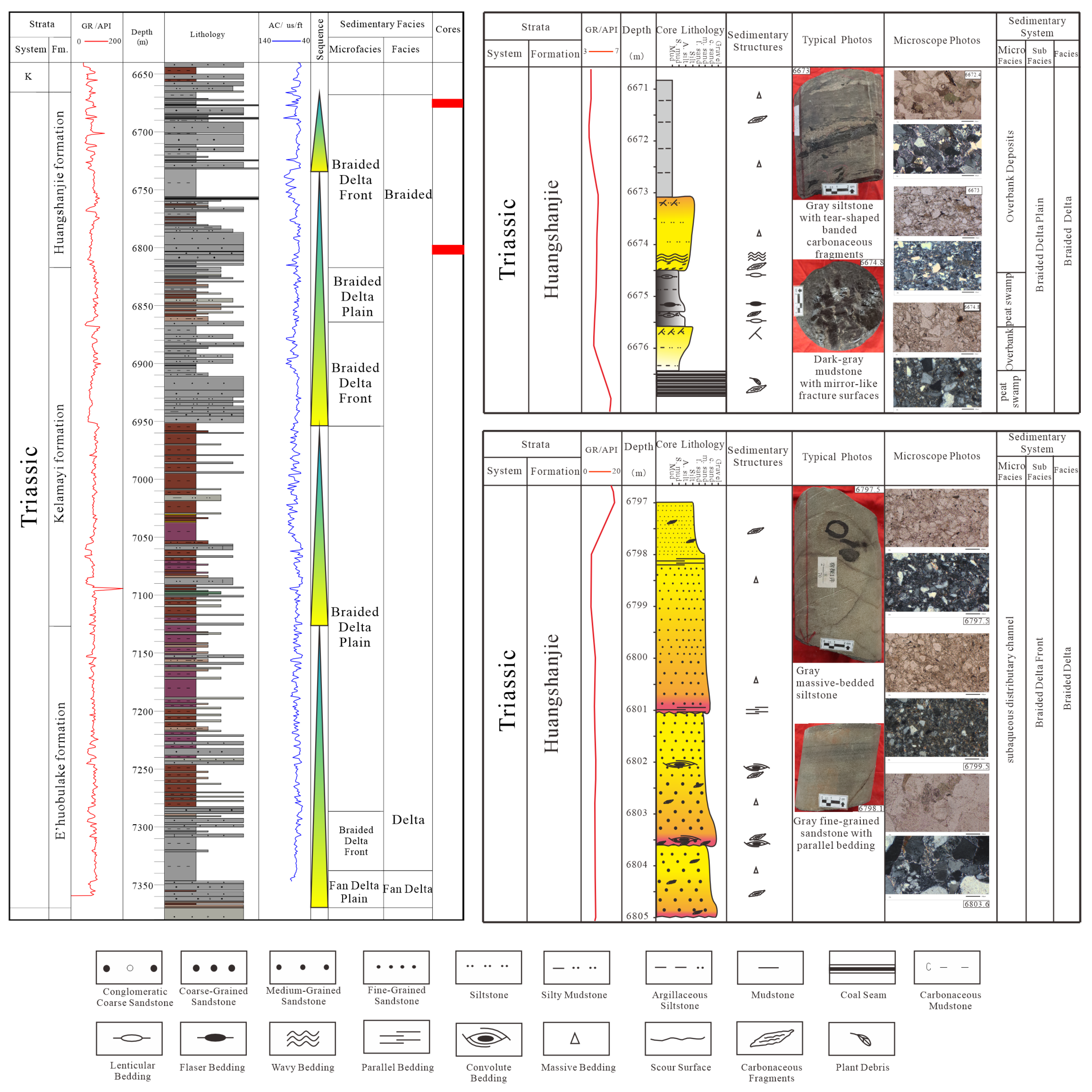
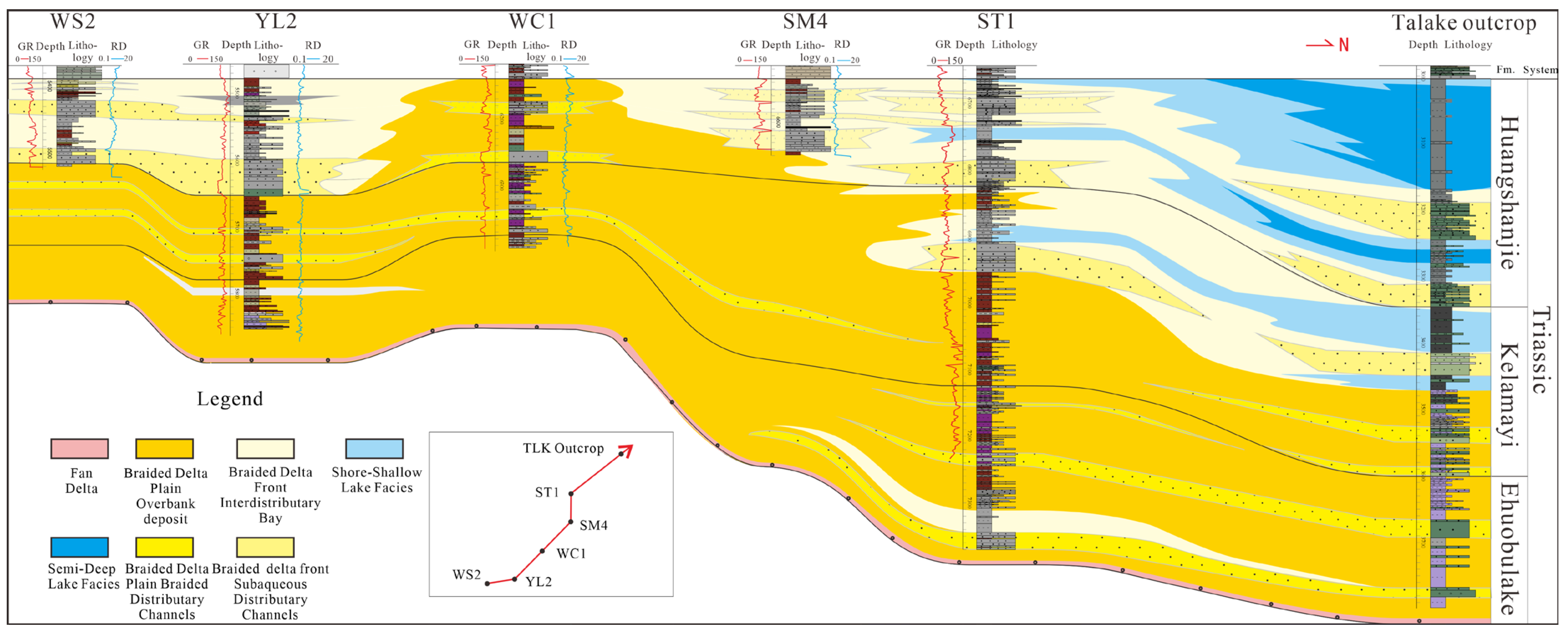
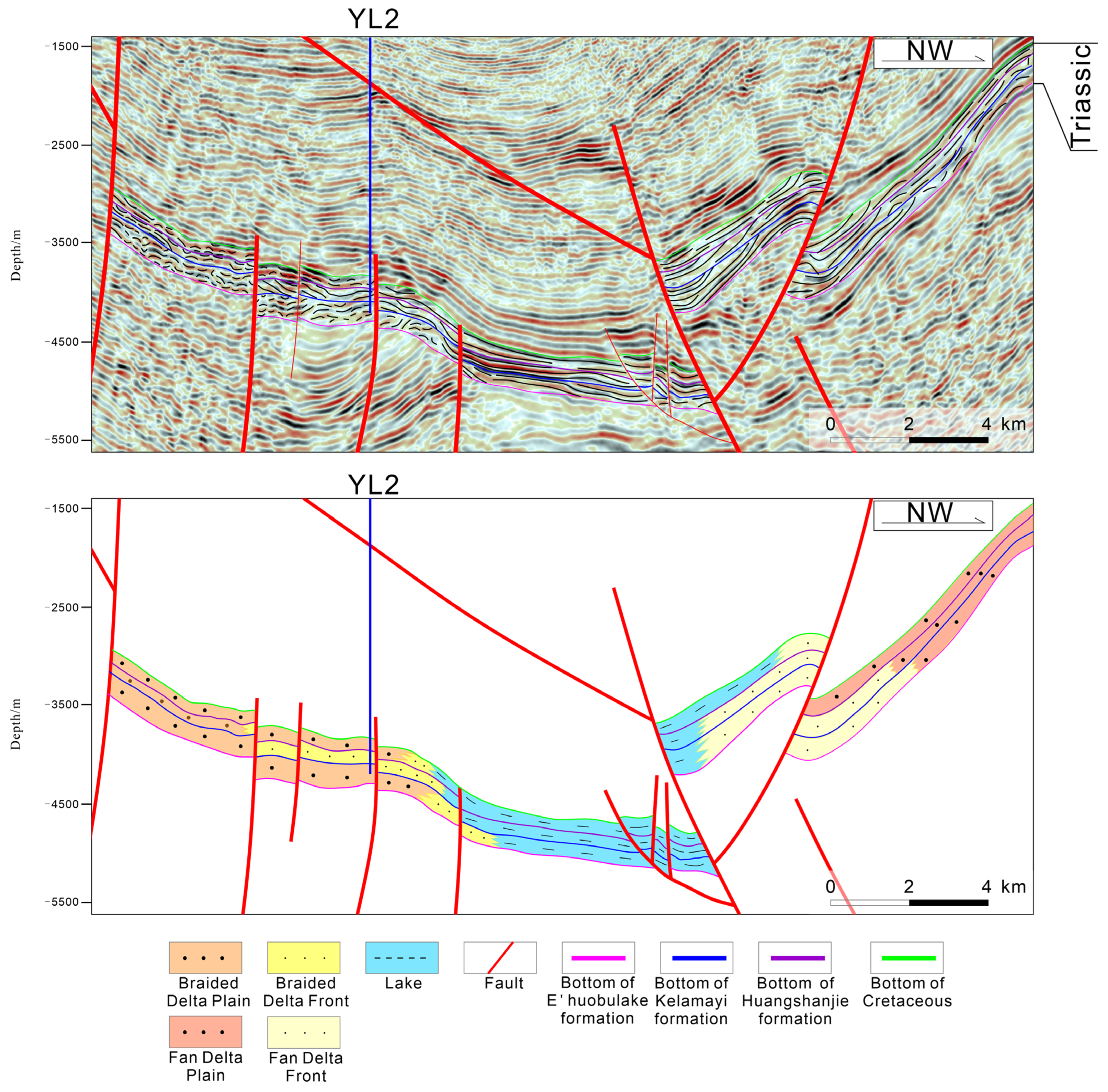
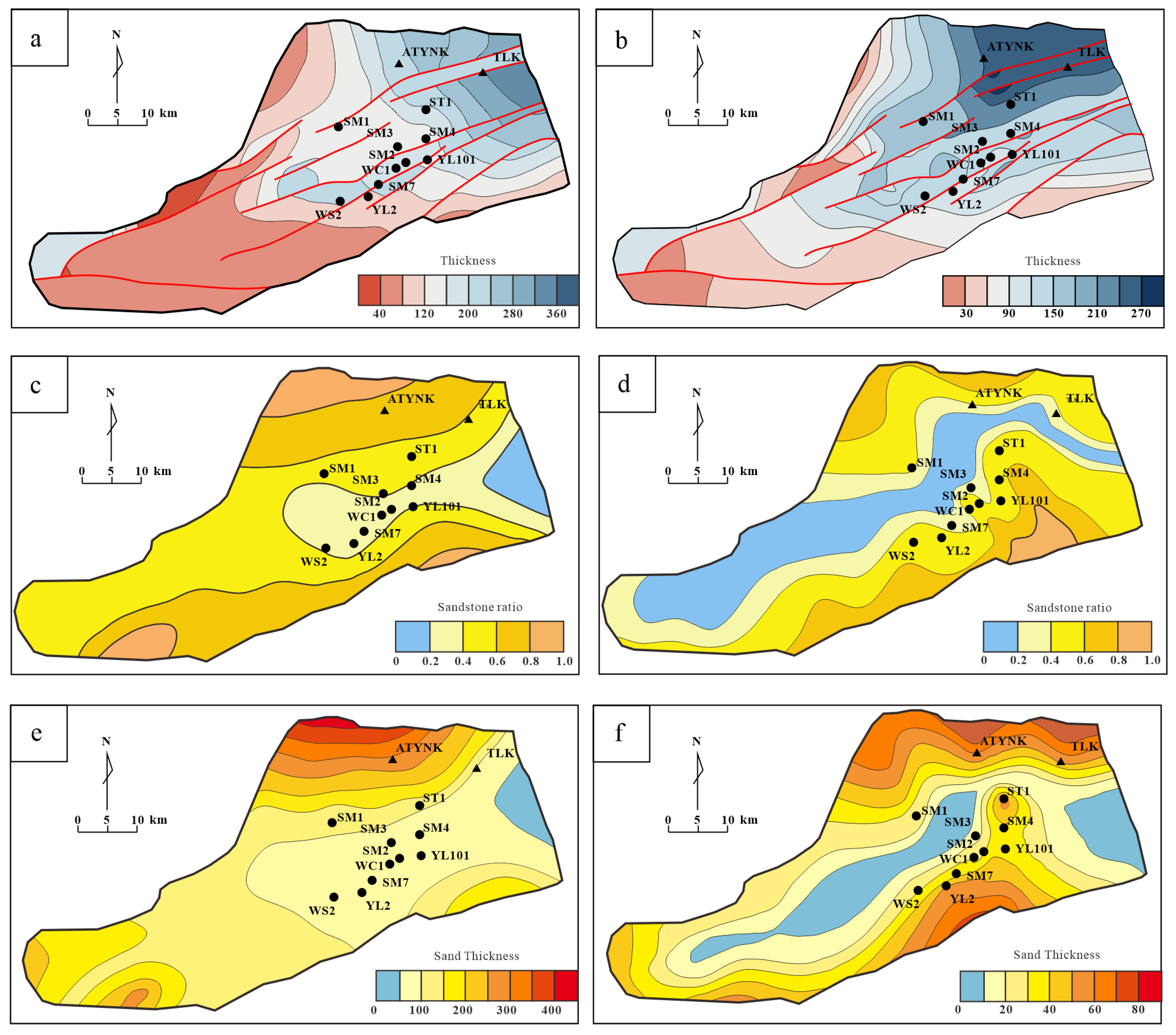

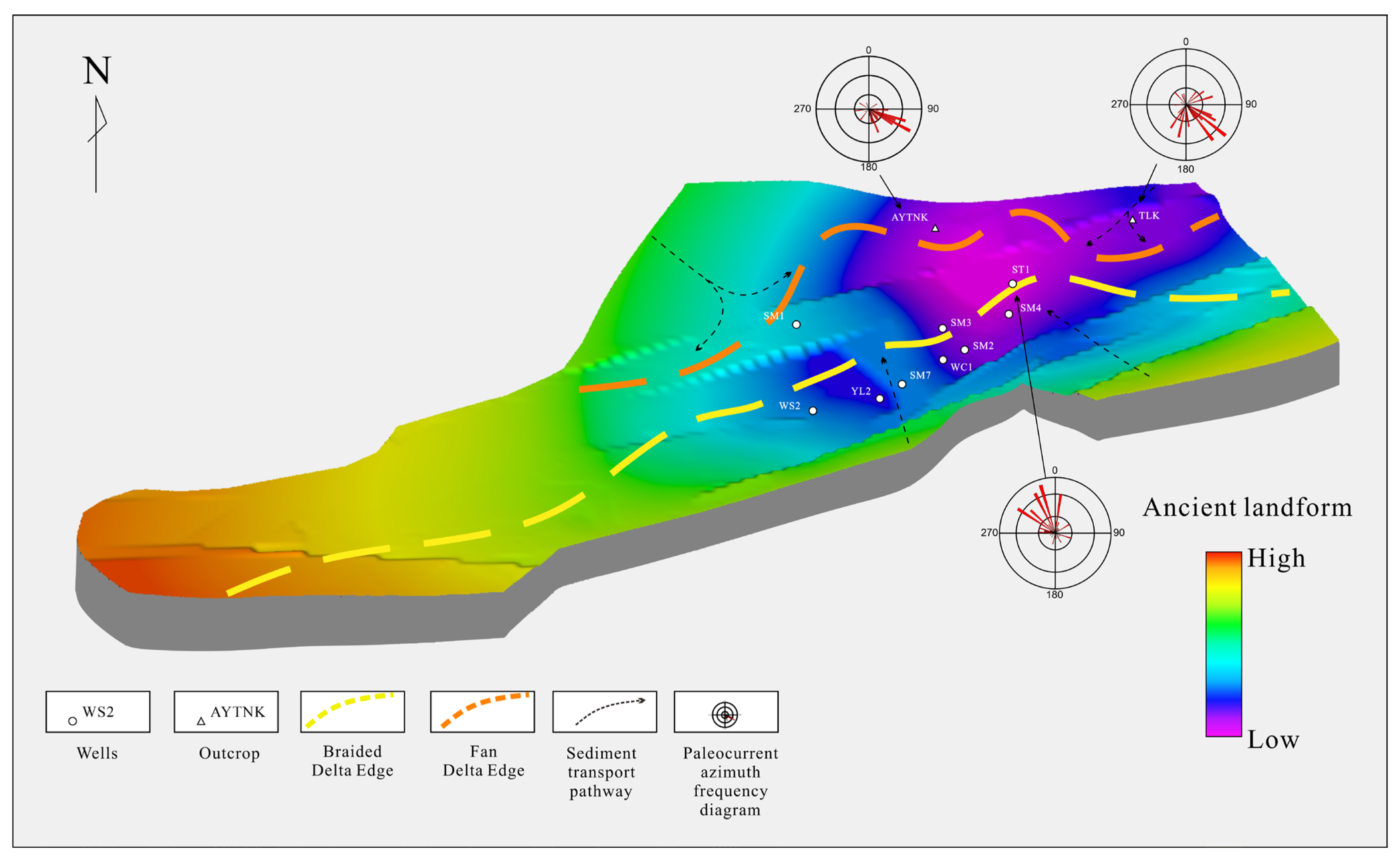

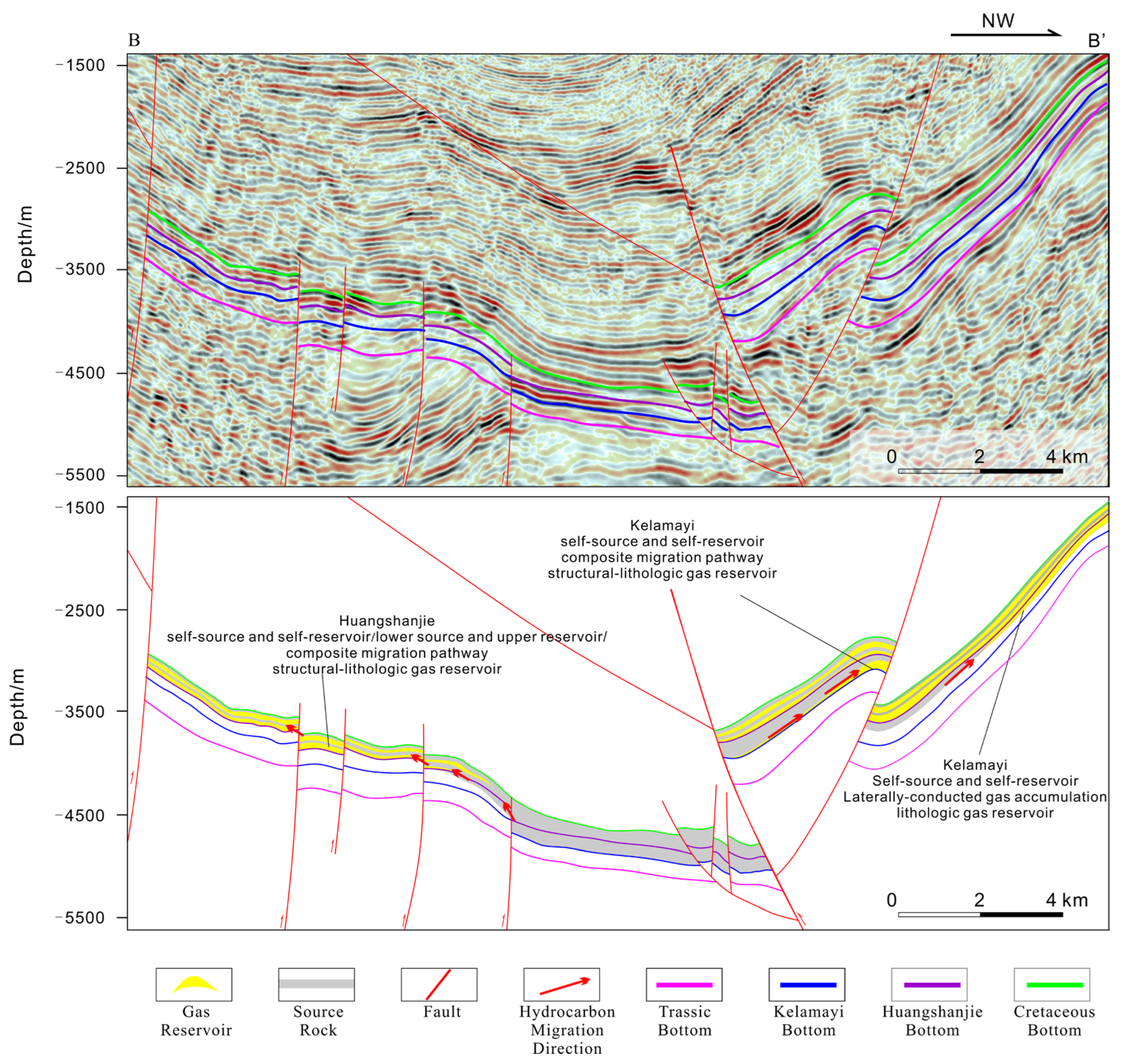
| Type | Seismic Profile | Characteristics | Geological Interpretation |
|---|---|---|---|
| SF1 | 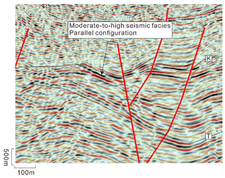 | Continuous, low-frequency (10 Hz), moderate-to-strong amplitude reflections | Lacustrine |
| SF2 |  | Moderately continuous, mid-frequency (15 Hz), medium-amplitude reflections | Braided-river-delta plain/Fan-delta plain |
| SF3 |  | Discontinuous, mid-frequency (12 Hz), weak-amplitude reflections | Braided-river-delta front/Fan-delta front |
Disclaimer/Publisher’s Note: The statements, opinions and data contained in all publications are solely those of the individual author(s) and contributor(s) and not of MDPI and/or the editor(s). MDPI and/or the editor(s) disclaim responsibility for any injury to people or property resulting from any ideas, methods, instructions or products referred to in the content. |
© 2025 by the authors. Licensee MDPI, Basel, Switzerland. This article is an open access article distributed under the terms and conditions of the Creative Commons Attribution (CC BY) license (https://creativecommons.org/licenses/by/4.0/).
Share and Cite
Fan, Y.; Hu, M.; Deng, Q.; Cai, Q. Sedimentary Characteristics and Petroleum Geological Significance of the Middle–Upper Triassic Successions in the Wushi Area, Western Kuqa Depression, Tarim Basin. Appl. Sci. 2025, 15, 7895. https://doi.org/10.3390/app15147895
Fan Y, Hu M, Deng Q, Cai Q. Sedimentary Characteristics and Petroleum Geological Significance of the Middle–Upper Triassic Successions in the Wushi Area, Western Kuqa Depression, Tarim Basin. Applied Sciences. 2025; 15(14):7895. https://doi.org/10.3390/app15147895
Chicago/Turabian StyleFan, Yahui, Mingyi Hu, Qingjie Deng, and Quansheng Cai. 2025. "Sedimentary Characteristics and Petroleum Geological Significance of the Middle–Upper Triassic Successions in the Wushi Area, Western Kuqa Depression, Tarim Basin" Applied Sciences 15, no. 14: 7895. https://doi.org/10.3390/app15147895
APA StyleFan, Y., Hu, M., Deng, Q., & Cai, Q. (2025). Sedimentary Characteristics and Petroleum Geological Significance of the Middle–Upper Triassic Successions in the Wushi Area, Western Kuqa Depression, Tarim Basin. Applied Sciences, 15(14), 7895. https://doi.org/10.3390/app15147895





